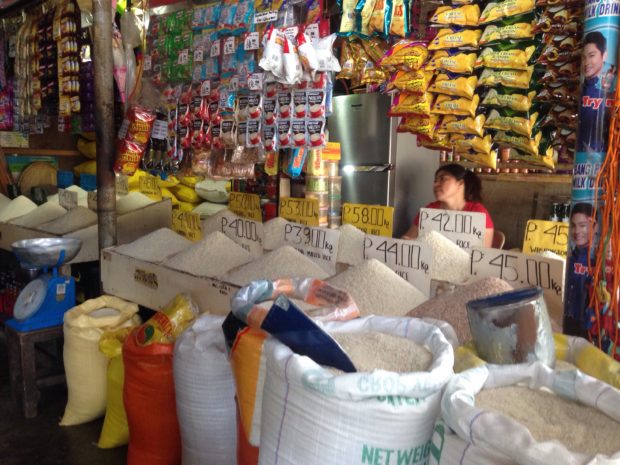
GOING UP Prices of commercial rice have gone up partly as a result of higher demand due
to theNational Food Authority’s decision to stop supplying cheap rice to retailers. —LEO UDTOHAN
The head of the Senate committee on agriculture and food wonders why the the rice supply of the National Food Authority (NFA) is only good for two days, down from the mandated 15 days.
Sen. Cynthia Villar, chair of the committee, also wonders why the NFA wants to import the staple when there is sufficient supply of domestically produced rice.
Villar filed a resolution on Wednesday “directing the proper Senate committees to conduct an inquiry in aid of legislation on the status of the NFA’s role in ensuring the stability of supply and price of rice.”
Also seeking answers is Cabinet Secretary Leoncio Evasco Jr., who chairs the NFA Council, which approves all plans to import rice.
Evasco said the council was investigating if there was really a “rice shortage” at the NFA or if its management was just trying to “pressure” the NFA Council into authorizing the purchase of more rice from abroad.
‘Just drama’
“Is it true or just drama to pressure the council to purchase rice?” Evasco said.
The NFA on Tuesday said its buffer stock as of Jan. 31 was down to only 64,000 metric tons, or just two days of the country’s consumption of the staple, when it was required to maintain a 15-day rice supply at any given time.
Because of its low rice inventory, the NFA recently stopped supplying the staple to retailers across the country, forcing the poor to buy the more expensive commercial rice, whose prices have gone up.
Retail prices up
In Tagbilaran City, Cresencia Castaño said a kilo of rice she had to buy directly from farmers cost P12 more than a kilo of NFA rice.
NFA rice in the Visayas can be bought for P27 a kilo for 25-percent broken grains, and P32 a kilo for 15-percent broken grains—cheaper than commercial rice, which costs from P40 to more than P50 a kilo.
Evasco said importing rice was a sensitive issue. “We have to be careful about purchasing rice from outside so as not to threaten our local farmers’ production.”
He said the NFA Council was tasked with protecting the government from “unscrupulous purchases of rice.”
Importation request
Evasco said that NFA management asked the NFA Council two weeks ago to allow it to use its standby authority to import 250,000 tons of rice.
The council, he said, decided not to act on the NFA management request because around 325,000 tons of rice under the government’s minimum access volume (MAV) rice importation program were set to arrive this month.
“We said we will not act on it because the MAV is set to arrive. In fact, the minimum access volume of 325,000 metric tons is now arriving,” he said.
Agencies like the Bangko Sentral ng Pilipinas, National Economic and Development Authority and Department of Finance are represented in the NFA Council.
No ‘urgent need’
Evasco also pointed out that the National Food Security Committee, which recommends the volume of rice to be imported, did not send any word that there was an “urgent need” to import rice.
The committee tracks down any rice shortage at present or in the coming weeks, according to Evasco.
Like Evasco, Villar doubted whether there was a rice shortage in the country.
She noted that the country had just harvested rice. “Only the NFA has a (supply) shortage,” she said.
The NFA has the money to buy rice from local farmers, especially those in the Visayas where unmilled rice is sold below P17 a kilo, according to the senator.
NFA spokesperson Rebecca Olarte said the agency’s capacity to buy palay was limited since its mandated buying price of P17 a kilo could not compete with private traders’ rate of more than P20 a kilo.
NFA blamed
Villar said it was the fault of the NFA if its rice supply was only good for two days.
The consumer rights group, Bantay Bigas, on Wednesday renewed calls for the government to raise the NFA buying price for palay, or unmilled rice to replenish its inventory.
“The NFA is repeatedly raising false alarm for a shortage to justify more importation, when they should be procuring more palay from Filipino farmers,” Bantay Bigas spokesperson Cathy Estavillo said in a statement.
Data from the Philippine Statistics Authority showed the country’s rice stocks as of Jan. 1, including those kept by households and those stored in commercial warehouses, totaled 2.85 million metric tons, equivalent to 84 days of consumption.
Villar said she would likely call for a hearing next week.
Evasco welcomed a Senate investigation into the alleged rice shortage. “We are at the beck and call of the Senate and Congress, for that matter,” he said. —Reports from Christine O. Avendaño, Philip C. Tubeza and Ronnel W. Domingo in Manila; and Inquirer Visayas